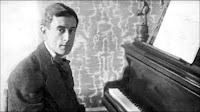My love of Ravels’ compositions goes all the way back to age
10 when I broke my arm and my mother bought a “stereo” (equivalent to what
would be today’s boom box or ipod) to entertain me until I could go back to practicing
piano. Along with the stereo, one of my first purchases was a recording of
Ravel’s famous Bolero; I listened to
it until the grooves wore out. Now I play two of Ravel’s most beloved
compositions on piano, Pavane pour une
Infante defunte and the Adagio Assai
from his Piano Concerto in G.
Reading Bolero: The life of Maurice Ravel (M. Goss, 1940) introduced
new insights that now bring deeper meaning and enhanced interpretation to his
compositions. Ravel is fascinating as a study in leadership as well,
particularly because his kind of leadership was one that often goes unrecognized
– simple, convicted, and pursued with little regard for influence. He made
music because he had to (“comme unpommier fait ses pommes”) instead of for the
purpose of advancing himself or making money.
Ravel’s father was Swiss and his mother from the Basque
region of Spain. His unique love of Basque culture led to a career-long fascination
with rhythm and dance. This, combined with a tendency to obscure emotion behind
a film of artistic restraint, came to be recognized as quintessentially French.
Numerous other composers influenced Ravel yet he remained unique.
Chabrier provided inspiration for the Pavane pour une Infante defunte,
the first of Ravel’s compositions to be widely embraced. Its delicate and
unwavering rhythm depicts a princess dancing the Pavane at court and becoming
so obsessed with its beauty that she loses all interest in anything else. His
most influential teacher was Faure and contemporaries included the likes of
Debussy, Satie, Massenet, Saint-Saens, de Falla, and Stravinsky (one of Ravel’s
closest life-long friends). He also interacted with many of the impressionist
painters (Verlaine, Monet, Manet, Renoir, and Degas) of the early 20th
century.
Many of Ravel’s compositions drew sharp disapproval from
critics and the public but made him a celebrity among his young artist
comrades. He composed in many different styles with one period focusing
exclusively on ballet and a later period incorporating elements of jazz. After
visiting America he reported that “American people have developed a distinct
national personality by combining different races into a united whole” which
resulted in “two distinct characteristics: underlying pathos… plus a hidden
yearning for an ideal which Americans hardly understand.” (62% through digital
text)
Ravel composed Bolero only a short time after returning
from his concert tour to America. Its pulsating beat never varied when Ravel
conducted it in concert and it is this constant forward movement, drawing the
listener to an eventual dramatic key modulation and explosive conclusion, that
made the piece so intoxicating. Another of Ravel’s last compositions, the Piano Concerto in G, incorporates a
similar rhythmic pulse in the middle movement (Adagio Assai) that supports a tender and elegant melody. The pace
and persistence of each of these compositions creates a captivating quality
much like the short life of this eccentric composer with the Basque heart and
restrained French sensibility.

No comments:
Post a Comment